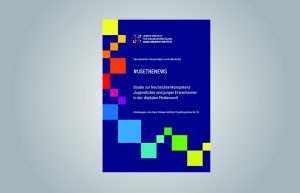#UseTheNews is the first scientific study to examine the news consumption habits of teenagers and young adults with such detail and precision. Prof. Dr. Uwe Hasebrink, Dr. Sascha Hölig, and Leonie Wunderlich conducted the study for the Leibniz Institute for Media Research on behalf of the German Press Agency (dpa) and the Hamburg Ministry of Culture and Media.
The study, which has been published only in German, is available for download: Hasebrink, Uwe; Hölig, Sascha; Wunderlich, Leonie (2021): #UseTheNews. Studie zur Nachrichtenkompetenz Jugendlicher und junger Erwachsener in der digitalen Medienwelt [#UseTheNews. Study on the News Literacy of Adolescents and Young Adults in the Digital Media World]. Hamburg: Verlag Hans-Bredow-Institut, April 2021 (Working Papers of the Hans-Bredow-Institut | Project Results No. 55). DOI: https://doi.org/10.21241/ssoar.72822
Learn more about the project “#UseTheNews – News Use and News Literacy in the Digital Age”
Key Findings
Journalistic Content Is Now Just One of Many Sources of Information
Of the young people surveyed between the ages of 14 and 17, 46 percent devote themselves to journalistic offerings several times a week. However, 58 percent also look to non-journalistic sources. All young people who subscribe to news on social media also regularly consume news from other sources.
Journalistic News Often Lacks Relevance to the Lives of Young People
In fact, half of young people do not consider it important to keep up with the news and current events. They often feel that news lacks relevance to their everyday lives. The most important reason to keep up with the news is to be able to participate in conversations with friends and family. This is how young people integrate into their social environment. Interestingly, young people who feel they can make a political difference express significantly more interest in information about current events.
There Is No Such Thing as the Teenager or the Young Adult
Even within the same age and education groups, there are different types of news orientation, each with specific characteristics regarding interest, usage, perceived relevance to opinion formation, and level of information:
- Journalistic information-oriented: high interest in news, extensive use and high relevance of journalistic sources with low relevance of non-journalistic offerings; well informed
- Low information-oriented: low interest in news, no use and relevance of journalistic sources with equally low use and relevance of non-journalistic offerings; not well informed
- Comprehensively information-oriented: high interest in news, extensive use and high relevance of journalistic and non-journalistic offerings; well informed
- Non-journalistic information-oriented: moderate interest in news, no use and relevance of journalistic sources with high relevance of non-journalistic offerings; not well informed


